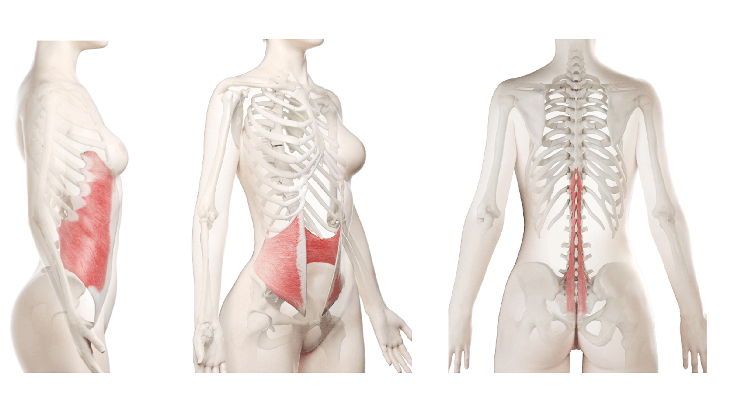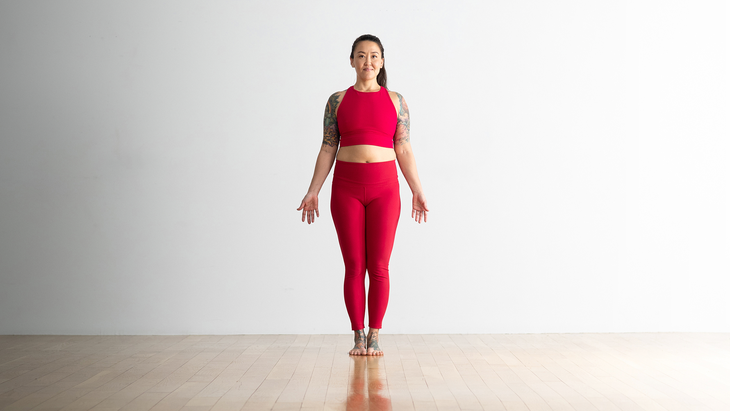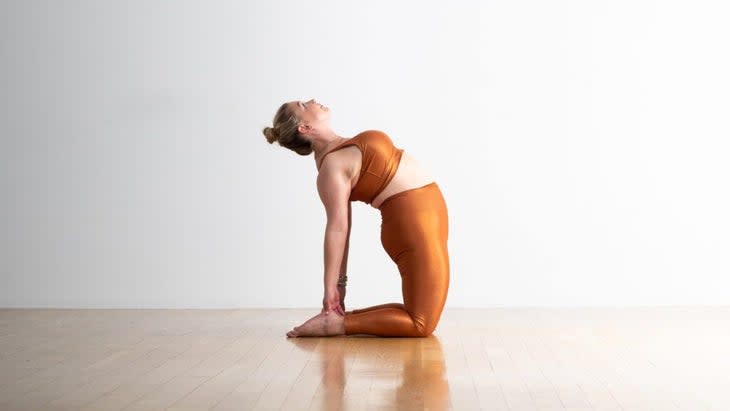44 Essential Cues to Help You Strengthen Your Core in Any Yoga Pose
This article originally appeared on Yoga Journal
Ever hear a yoga cue that completely changed your understanding of a pose or an anatomical action? Or, on the flip side, have you ever struggled to decipher a cue that made no sense whatsoever in your body or your mind?
Language is intensely personal. It filters through our unique perceptions and past experiences such that no single cue or phrase that will land the same way for every student.
Nowhere is that more true than cues that relate to engaging our core. A coordinated community of muscles work together to surround and support our entire midsection, including our back and side body. But we often tend to overfocus on cues related to the abdominals, which can carry the loaded and misleading message that core engagement is synonymous with the imagined requirement of a "flat" or "tight" stomach. What we miss with this tunnel vision is an appreciation of the side and back body and the general stability they provide.

How to engage--and strengthen--your entire core
In truth, everyday life actually asks us to recruit our core muscles all the time, in varying degrees, to support ourselves against gravity, create stability during movement, even assist our breathing. While a cue like "engage your core" works for some of us in some poses, a more realistic way to tap into the core is to focus on a familiar feeling, movement, action, or outcome.
If certain cues mean nothing to you or seem to fall on deaf ears when you're standing in front of a class, then it's time to try alternate options. Approaching yoga cues with a less rigid mindset, whether you're a student or a teacher, can lead to alternatives that can help cut through the clutter and confusion and help you or your students find the engagement, the strength, and the stability that we need.

Poses that ask you to round your spine
Perhaps the easiest place to start is in any scenario in which we want to engage the rectus abdominis, our so-called "6-pack" muscle, to round the spine as we do in poses like Bakasana (Crow or Crane Pose) and even Marjariasana (Cat Pose).
Often it works best to reference the visible structures so familiar to us on the front of our bodies. This includes cues like "scoop your belly" or "hollow your belly," as well as "draw your belly in and up," "pull your navel toward your spine," "coil in," or "curl in."
But relating a cue to the action on the opposite side of the body can also catch our attention and invite a different sort of awareness. For example, in Crow, you could "try to stretch the skin across your low back." And in supine core work, such as crunches, you could "press your low back into the floor."

Back bends
These same core work cues that help you scoop your abs and round your back won't help you in backbends. These poses require you to find the opposite engagement and movement in your body.
In poses such as High Lunge and Ustrasana (Camel Pose), where gravity can move us deeper into a backbend than our low back might appreciate, more subtle core support is required. To create a coordinated effort between the chest and anterior hips, try "draw your front ribs in and down" to focus on front body engagement rather than focusing exclusively on the low back.
Or you can instead draw attention to the back body. "Inflate your kidneys" can highlight more targeted action in the upper portion of the rectus abdominis. To highlight the required action in the lower portion of the same muscle, try "draw your pubic bone toward your navel," "lift your lower abdomen," "lengthen your sacrum," or even "zip up your jeans."
Standing poses that ask you to keep your spine neutral
Poses that require us to find an upright and neutral spine can be cued with common phrases such as "reach through your crown," "stand tall," and even "press the ceiling away," such as Tadasana (Mountain Pose), Virabhadrasana II (Warrior 2 Pose), and Vrksasana (Tree Pose). These cues subtly recruit our deepest abdominal muscle, the transversus abdominis or TVA, which encircles our waist. Somewhat like the corset it resembles, the TVA draws our abdominal contents slightly closer to the spine and makes us feel taller, a subtle postural action called axial extension.
Horizontal or inclined poses that ask you to keep your spine neutral
That same axial extension requires more deliberate effort when we are asked to hold the spine neutral in a horizontal or inclined orientation to gravity. Here, the increased downward pressure or pull on our midsection from gravity creates the potential for sagging. Imagine being in Plank, Forearm Plank, or the variation to Tabletop with opposite leg and arm extended and hearing the suggestion to "hug the midline," "cinch in around your waist," "narrow your waist," or "lengthen from head to heels." These can help you engage in a manner that sustains the necessary engagement to lift throughout your core.
The challenge of maintaining a neutral spine in a pose increases as we factor in our limbs. In Navasana (Boat Pose) or reclining leg lifts, where the weight of our legs could cause our backs to inadvertently arch, a cue like "draw your front hip points toward each other" can help increase the level of TVA engagement.
The load increases even more when you factor in the placement of your limbs, such as in single arm or leg Plank variations or a neutral spine arm balance like Eka Pada Koundinyanasana II (Hurdler’s Pose), it can help to add superficial muscular reinforcement to the more subtle support of the TVA. In this instance, you could up the ante with a cue like "brace yourself like you're ready for a punch in the gut." (It runs counter to the principle of ahimsa, but it works!)
See also: Planksgiving: A Month-Long Plank Challenge
Twists and side bending poses
We often overlook the fact that core work includes twists and side bends. These types of postures demand engagement from less familiar core muscles, including our oblique abdominals and the quadratus lumborum along the side body.
Action-oriented cues can help us eke out that extra strength. In Utthita Parivrtta Anjaneyasana (Revolved Lunge), think "draw your sternum toward your front knee." In an open twist such as Utthita Trikonasana (Extended Triangle Pose), consider "turn your chest toward the side wall" or "lift your side waist away from the floor." When you're balancing in Vasisthasana (Side Plank), try "squeezing your low ribs toward your hip."
Feeling-oriented cues, such as "rinse out" or "wring out your abdomen," also work in a similar way in twisting poses.
Transitions between poses
Moving mindfully from one position to another is one of the most functional ways we can employ our core muscles in yoga and in life. And, as with most things, less is more. A cue as simple as "exhale" could be the simple reminder we need to tap into the subtle contraction of the TVA. Adding a single word or descriptive phrase, such as "slowly," "softly," or "with control" can help us benefit from the coordination of core muscles without having to think about them directly or individually.
In stronger or higher velocity transitions, some mindful cues include "land light" or "tread softly," for example, when stepping forward from Adho Mukha Svanasana (Downward-Facing Dog Pose) to a lunge or bringing your foot back to the mat from Ardha Chandrasana (Half Moon Pose). You could try "float forward" to encourage control during the transition between Down Dog and Uttanasana (Standing Forward Bend) and "float back" for the opposite movement. I once heard a teacher suggest that we "imagine a sleeping baby at the top of our mat" to inspire quiet landings during handstand hops.
Sneaky ways to cue the core
We rarely think about the need to contract our core in everyday life. It's simply instinctual. We engage our core muscles in various ways that support other muscles in an array of situations.
So in active yoga poses, perhaps the most effective way to trigger core engagement might be to reference the types of actions or sensations that are most familiar to us or students.
"Press through your heel(s)" or "press through the ball(s) of your feet" works well in poses where we are vividly aware of the need for strong legs supported by a strong core. Think of Plank, Utthita Hasta Padangusthasana (Extended Hand-to-Big Toe Pose), and Navasana (Boat Pose).
"Squeeze your legs together" and "magnetize your feet toward each other" tap into the abdominal muscles via the fascial connections to the hip adductors and can be effective in poses such as Plank, Side Plank, Warrior 2, and Utkata Konasana (Goddess Pose).
Even an action seemingly unrelated to the core, like "press your palms together" in Anjali Mudra (Salutation Seal or Prayer Hands) or "hug your forearms toward the midline" in Plank work to engage lesser-used parts of our core.
How to navigate cues in general
Our core muscles sometimes work most efficiently when we don't think about them at all. So play with language that taps into a feeling, movement, action, or outcome. Whether these cues work for you or inspire you to come up with others, you have nothing to lose from experimentation.
About our contributor
Rachel Land is a Yoga Medicine instructor offering group and one-on-one yoga sessions in Queenstown New Zealand, as well as on-demand at Practice.YogaMedicine.com. Passionate about the real-world application of her studies in anatomy and alignment, Rachel uses yoga to help her students create strength, stability, and clarity of mind. Rachel also co-hosts the new Yoga Medicine Podcast.
For exclusive access to all of our fitness, gear, adventure, and travel stories, plus discounts on trips, events, and gear, sign up for Outside+ today.

